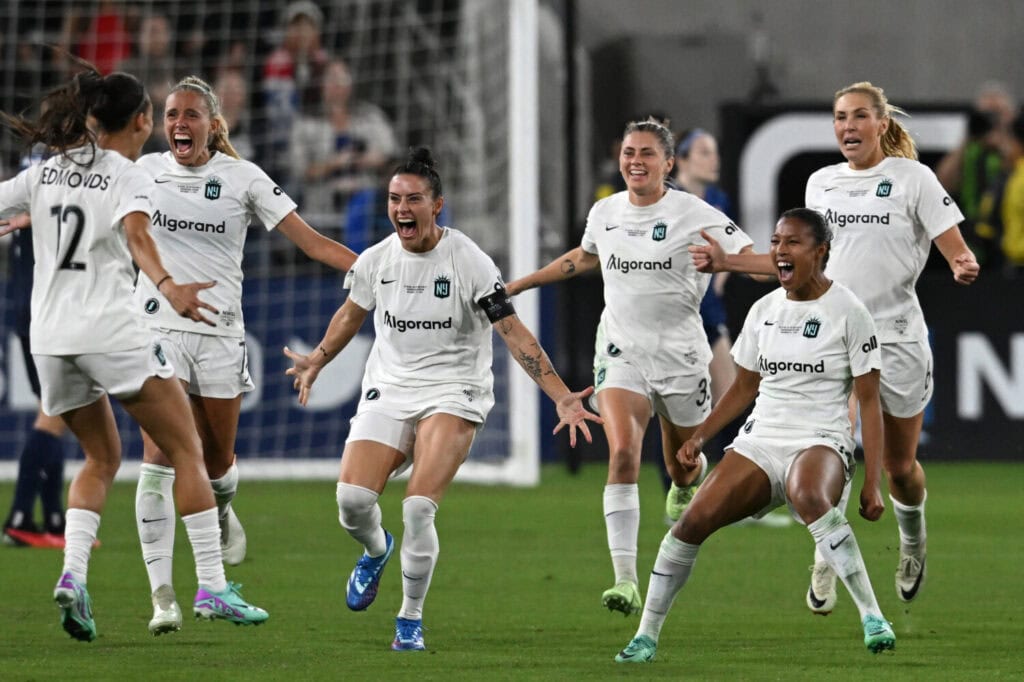Following the league’s breakout broadcast deal, the NWSLPA drove early negotiations to secure the future of its talent.
The NWSL Players Association (NWSLPA) has agreed to terms on a historic new collective bargaining agreement. Negotiations towards the deal kicked off early, driven by the NWSLPA and inspired by the massive growth of the league over the last several years.
The NWSLPA’s executive director – and former professional soccer player – Meghann Burke calls the new agreement “transformational.” Per the terms, the league will eliminate the draft, effective immediately. The NWSL becomes the first American professional sports league to do away with the draft, putting it on equal footing with the international market. “It was very, very important to secure every player’s right to control their own destiny [and] to have autonomy over their careers,” Burke told Boardroom. “I think, especially given the history of this league, it was even more important that a player is able on their own terms to navigate a negotiation and to be informed and to be able to have a say in where they go and on what terms.”
Additional key highlights of the CBA include:
- Free agency for all
- Guaranteed contracts
- Elimination of trades without player consent
- Guidelines for workload management
- Revenue sharing
The new deal builds on the league’s first-ever CBA, ratified in 2022, and will extend through 2030.
The new CBA comes at a pivotal time for the league, as it seeks to expand to 16 teams by 2026. The NWSL has seen enormous growth over the last several years, fueled in large part by the increased popularity of its players. Late last year, the league announced a new broadcast deal worth $240 million. More recently, Bob Iger and Willow Bay purchased Angel City FC at a $250 valuation, marking the highest-ever valuation for a professional women’s sports team.
Collectively, these markers of the league’s evolution combined to create leverage for the PA to advocate for its players. Former NFLPA executive director DeMaurice Smith noted that this leverage is the most essential thing one side can bring to a bargaining table. However, even under the best conditions, the process can be brutal. Smith described the process of negotiating a deal like this as “the closest thing to close contact knife fight that you could have in a boardroom.”
As the league continues to develop, the new deal puts players in position to benefit directly from its growth. Burke noted that the details of revenue sharing will enable players to secure enhanced benefits as the league approaches its next broadcast deal in 2027, predicting that it will be “even more significant” than what was announced in 2023. She went on to say, “For women’s soccer in general, we’re on an upward trajectory and we need people to be creative to continue that same trajectory and actually make it mutually beneficial for everybody that’s involved.” The new CBA seeks to do precisely that. Plus, it includes an option for early re-negotiation should the conditions change drastically enough to merit a new set of benefits for players.
Looking back on the process, Burke praised the players and the PA, noting that the terms create a new standard in women’s sports that tends to the specific needs of female athletes. “The sports industry has been dominated for decades by the interests of men’s sports,” Burke said in an official statement. “It’s changing because of the Players.”

In addition to the key highlights, the deal also includes an expanded suite of benefits for maternal health and childcare, housing protections for players, and a one-time, modest payment to the players who helped build the league “to acknowledge their contributions,” according to Burke.
NWSLPA president Tori Huster expressed her excitement for the deal, telling Boardroom that the final product reflects the PA’s efforts to look out for the best interests of every player in the league. “We wanted no person left behind,” she said. “We still wanted them to enjoy playing in our league and also earn money doing that. We think that that’s something that the league could afford to do at this point and we pushed hard for that.”
Overall, the new CBA enables empowering conditions for the players. However, for Burke and Huster, they see potential for it to transform negotiations beyond the NWSL. “I certainly hope that I think other leagues will be looking at this contract. We’re the first to actually achieve what has been imagined by American athletes for decades,” Burke said. “For baseball, football, basketball, men’s soccer, this is going to provide a blueprint for how it can be done.
“I think what our contract is going to show in the next several years is proof of concept that not only is it possible, but it’s actually mutually benefit to the entire ecosystem to create a system where athletes and teams can enter into these relationships from a place of choice and loyalty too.”